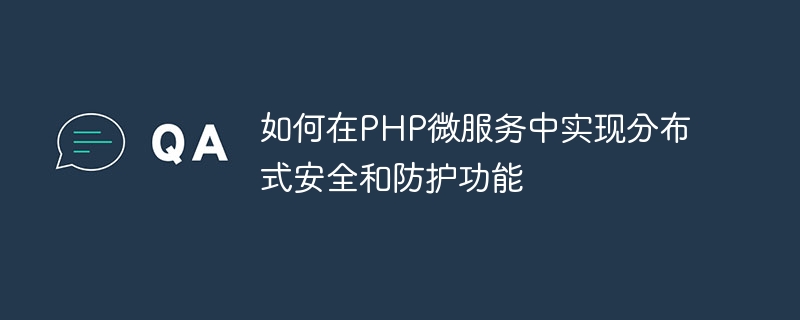

How to implement distributed security and protection functions in PHP microservices
With the development of the Internet, microservice architecture has gradually become the mainstream architecture model for enterprise development. For microservice architecture, protecting the security of distributed systems is crucial. This article will introduce how to implement distributed security and protection functions in PHP microservices and provide specific code examples.
1. Use JWT for authentication
In the microservice architecture, users need to authenticate between different microservices. In PHP, we can use JSON Web Token (JWT) to achieve authentication. JWT is an open standard that uses JSON as the payload and uses a key for signature to ensure the validity of the identity token.
The following is a sample code for authentication using JWT:
composer require firebase/php-jwt
use FirebaseJWTJWT;
function generateJWT($userId) {
$payload = array(
"userId" => $userId,
"iat" => time(),
"exp" => time() + (60*60) // 设置令牌过期时间为1小时
);
$jwt = JWT::encode($payload, "your-secret-key");
return $jwt;
}use FirebaseJWTJWT;
function verifyJWT($jwt) {
try {
$decoded = JWT::decode($jwt, "your-secret-key", array('HS256'));
return $decoded->userId;
} catch (Exception $e) {
// 验证失败,处理异常
return false;
}
}By using JWT for authentication, we can ensure that the user is authenticated on different Secure access between microservices.
2. Use OAuth 2.0 for authorization management
In addition to identity authentication, authorization management is also an important part of achieving distributed security. In PHP microservices, we can use OAuth 2.0 to implement authorization management.
The following is a sample code using OAuth 2.0 for authorization management:
// 省略认证逻辑,假设用户已通过身份验证 $authorizationCode = generateAuthorizationCode(); storeAuthorizationCode($authorizationCode, $userId, $redirectUri); // 返回授权码给客户端 return $authorizationCode;
function getAccessToken($authorizationCode) {
$params = array(
"grant_type" => "authorization_code",
"code" => $authorizationCode,
"client_id" => "your-client-id",
"client_secret" => "your-client-secret",
"redirect_uri" => "https://your-redirect-uri"
);
$ch = curl_init();
curl_setopt($ch, CURLOPT_URL, "https://auth-server/token");
curl_setopt($ch, CURLOPT_POST, 1);
curl_setopt($ch, CURLOPT_POSTFIELDS, http_build_query($params));
curl_setopt($ch, CURLOPT_RETURNTRANSFER, true);
$response = curl_exec($ch);
curl_close($ch);
$accessToken = json_decode($response)->access_token;
return $accessToken;
}By using OAuth 2.0 for authorization management, we can achieve secure authorization between microservices.
3. Implement defense technologies
In addition to authentication and authorization management, we also need to implement some defense technologies in PHP microservices to protect the security of the system.
Here are some examples of common defense techniques:
Use prepared statements and parameterized queries instead of directly injecting users Input is spliced into SQL statements.
Verify and filter all inputs, and escape the output.
Use CSRF tokens to verify the legitimacy of form submissions.
Use load balancer and web application firewall to filter malicious requests.
Summary:
Implementing distributed security and protection functions in PHP microservices is a complex task, but by adopting appropriate technologies and methods, we can protect our distributed systems from subject to various security threats. This article introduces specific code examples of using JWT for authentication, using OAuth 2.0 for authorization management, and implementing defense technologies. We hope it will be helpful to readers in implementing distributed security and protection functions.
The above is the detailed content of How to implement distributed security and protection functions in PHP microservices. For more information, please follow other related articles on the PHP Chinese website!




